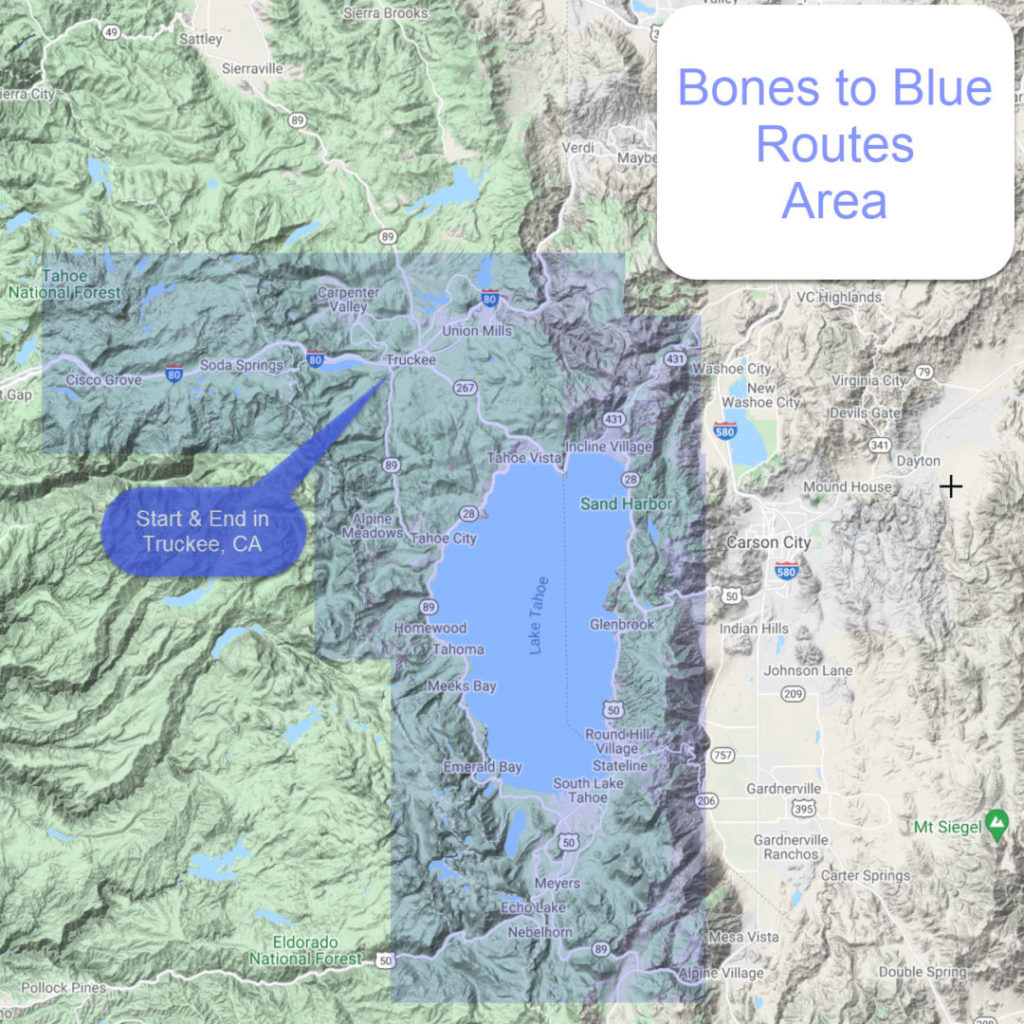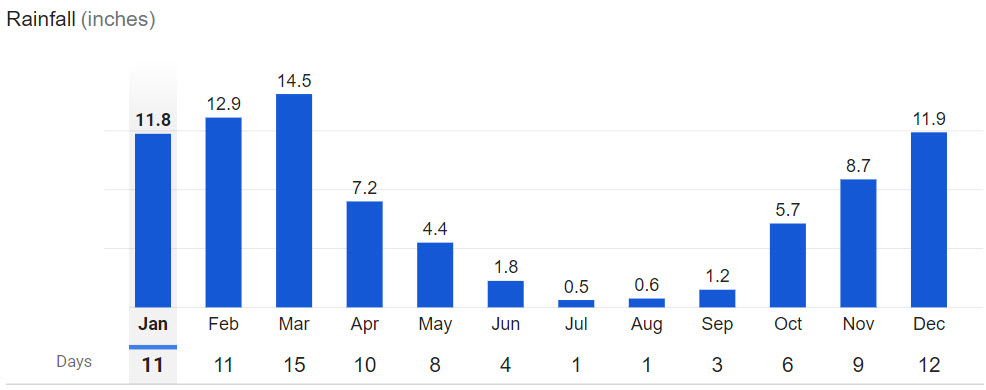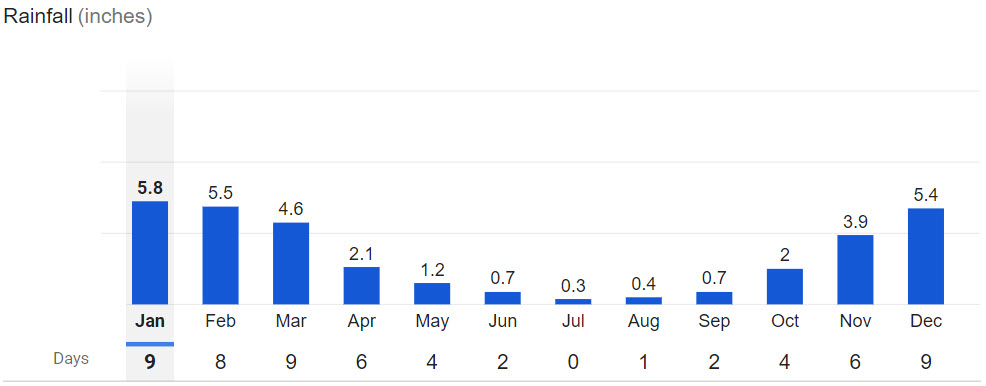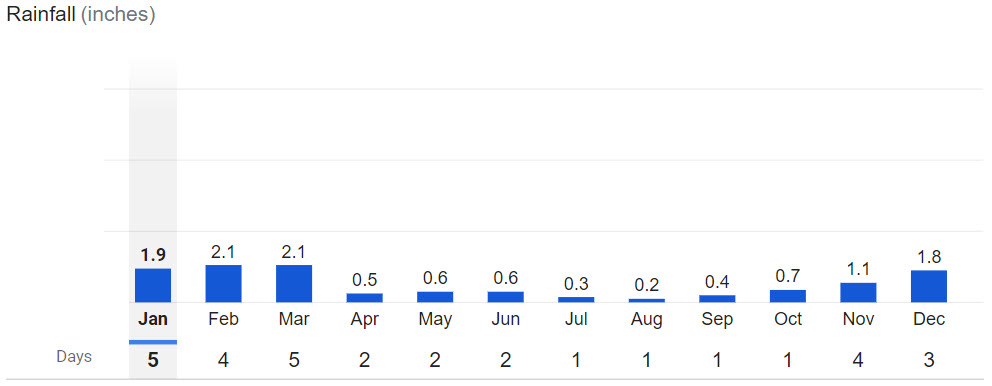Best time to ride
The season for the Bones to Blue routes is June through October. All things considered, the best conditions are usual mid August to mid September with reasonable temps and lower chances of rain.
Annual snowpack varies, but the routes are often clear by mid June. The last section to open up is usually the southwest section of the Tahoe Rim Trail (Freel and Armstrong Pass). Early October may offer short windows of good weather and reasonable temps at night. Snow can, however, arrive as early as September, so keep an eye on forecasts.
Temps in July and August can reach (mid 80’s) and fewer streams are running, so you might need to carry more water. The fire and smoke season is usually July through October.

Average Monthly Temps
Soda Springs CA

Incline Village NV

Stateline NV

Average Monthly rainfall
Soda Springs CA

Incline Village NV

Stateline NV

Start and End Location
All of the routes start and end in Truckee, CA.
Logistics for where to stay and park your vehicle in Truckee are included in your Guide Pack.
Recommended Bike and Tires
The routes were designed with hardtail of full-suspension mountain bikes in mind. The routes focus on incorporating amazing singletrack trails that, at times can be chunky and technical. Your tires should be at least 2.3″ wide and have knobby tread. If you ride a hardtail, lean towards mid-fat tires (2.5+), so you can run lower pressure and get a smother ride.
Tubeless is strongly recommended because there are plenty of pokey things along these routes. See some tire suggestions in recommended gear.
A low gear of 30/50 (smallest chainring/biggest cassette ring) should work fine for most people. Lower is even better if your bringing “everything” on your fully-loaded tour.
Recommended Gear List
For a complete Bones to Blue packing list see here. The recommended gear list for Bones to Blue assumes that your main goal is to finish the route in 3-4 days. If you are trying to crush it in less than 48 hours or tour for 6+ days, modify as necessary.
Bike – Given the amount of rough terrain, consider either a full-suspension or a hard-tail bike with wide tires (2.35-3.0). A full-suspension bike will smooth out the trail, but limits what you can carry on your bike frame.
GPS – Garmin Etrex 20x and Etrex 30x are well-tested and widely used in bikepacking events.
GPS backup – It’s always a good idea to have a backup option on your phone in case your GPS dies. I use Backcountry Navigator Topo GPS ($12 app on android). Upload the tracks and waypoints to the app and, with your phone on “airplane” mode, you can probably navigate for 1 day or so before your battery dies. See this article for more tips on using your phone as a gps.
Backup phone battery – The Anker battery is great for keeping your phone charged for a reasonable weight penalty. It can quickly recharge your phone 2.5 times.
Tires – Maxxis Ikon 2.35 are a good default. Err on the side of wider tires. The terrain is very mixed (chunky and smooth single track, dirt/gravel fire roads, and some pavement).
Chain lube – Finish Line Dry is a good choice. The trails are often dry and dusty, but you will cross a number of streams. Plan on lubing your chain 1 or more times a day.
Spare spoke –The FiberFix Emergency Spoke has saved me on 3 different occasions. It can replace a drive-side spoke without removing the cassette.
Water Filter – Sawyer’s PointOne Squeeze Filter is small, light, effective, and efficient. Getting cold water from a mountain stream without having to wait for pills to dissolve is heavenly. Carry a spare squeeze bag or iodine pills because I’ve had a brand new bag suddenly split and bust open.
Bear bag – The Ursack is a great option for bagging your food at night. There are lots of bears along the route. One bikepacker on the Tahoe Rim Trail in 2017 woke up with a bear next to him eating his food supply.
Tire plugs – Genuine Innovations UST Tubeless Plugs can get you out of bind when a stick or rock stabs your tire and you start losing sealant. In 2017, Matt and I both had to plug our tires during the race.
Bugs – Sea to Summit Mosquito Head Net is a great compliment to a bivy bag. It’s compact and light.